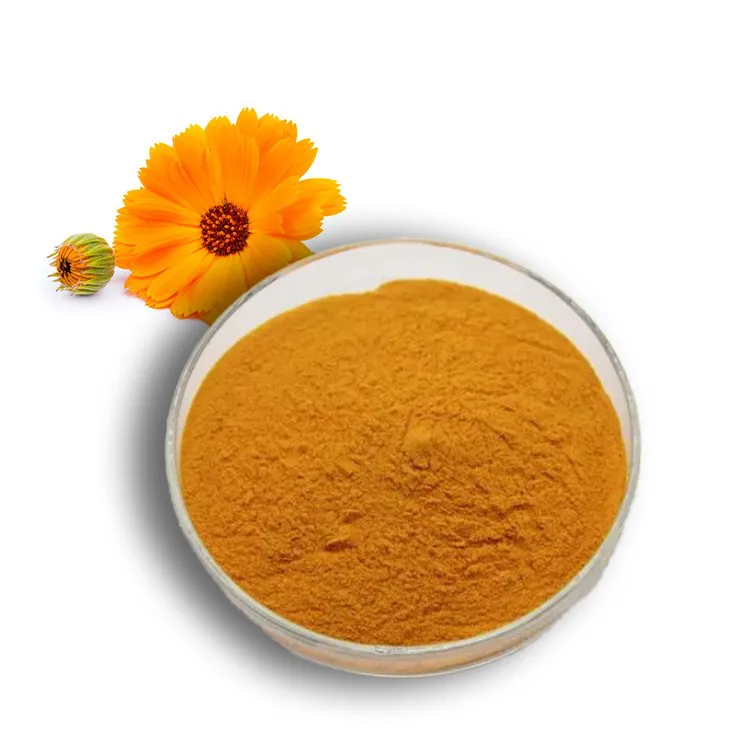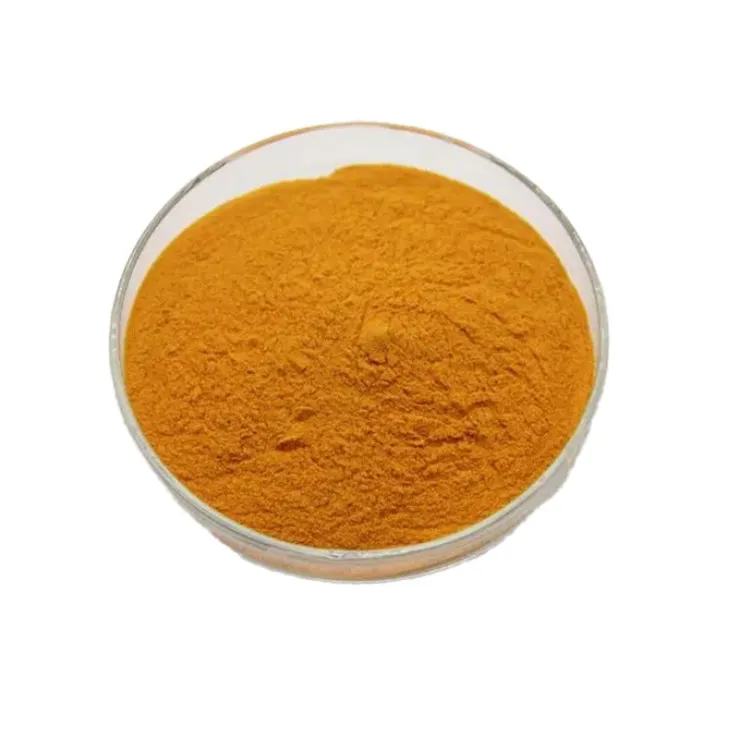- 0086-571-85302990
- sales@greenskybio.com
The best calendula extract on the market.
2024-11-30

Introduction
Calendula Extract has emerged as a highly sought - after ingredient in a wide range of industries. Its popularity can be attributed to its numerous beneficial properties. In this article, we will explore in detail what sets the best Calendula Extract apart in the market.

Origin of Calendula
Calendula, also known as pot marigold, is a plant that has been used for centuries. Native to the Mediterranean region, it has now spread across various parts of the world. The quality of Calendula Extract can be significantly influenced by its origin. Different regions may have variations in soil quality, climate, and sunlight exposure, all of which can impact the plant's growth and the composition of its extract.
For example, calendula grown in regions with rich, well - drained soil and ample sunlight may produce flowers with a higher concentration of active compounds. This, in turn, can lead to a more potent and effective extract.

Extraction Methods
Solvent Extraction
One of the most common methods of extracting calendula is through solvent extraction. Solvents such as ethanol, glycerin, and hexane can be used. Ethanol is a popular choice as it is effective in extracting a wide range of compounds from the calendula flowers while being relatively safe for use in products that come into contact with the skin or are ingested (in the case of food applications).
When using solvents, the ratio of solvent to calendula material, the extraction time, and temperature all play important roles. For instance, a longer extraction time at an optimal temperature may result in a more complete extraction of the desired compounds. However, it is also crucial to ensure that the extraction process does not degrade the active components.
Supercritical Fluid Extraction
Supercritical fluid extraction is a more advanced method. Carbon dioxide (CO₂) is often used as the supercritical fluid in this process. This method has several advantages. It is a cleaner process as CO₂ is non - toxic and leaves no residue. It also allows for a more selective extraction, meaning that specific compounds can be targeted more precisely.
The conditions for supercritical fluid extraction, such as pressure and temperature, need to be carefully controlled. At the supercritical state, CO₂ has properties that make it an excellent solvent for extracting calendula's beneficial compounds.

Applications in Skincare
Calendula extract has a plethora of applications in skincare.
- Anti - Inflammatory Properties: It is highly effective in reducing inflammation. This makes it ideal for treating skin conditions such as eczema, psoriasis, and acne. Calendula extract can soothe irritated skin, reducing redness and swelling.
- Antioxidant Activity: The antioxidants present in calendula extract help to protect the skin from damage caused by free radicals. Free radicals can be generated by environmental factors such as UV radiation, pollution, and smoking. By neutralizing these free radicals, calendula extract can help to prevent premature aging of the skin, including the formation of wrinkles and fine lines.
- Skin - Soothing: It has a natural ability to calm and soothe the skin. This is especially beneficial for sensitive skin types. Calendula extract can be used in creams, lotions, and masks to provide a gentle and nurturing effect on the skin.

Applications in Healthcare
Beyond skincare, calendula extract also has important applications in healthcare.
- Wound Healing: Calendula has been traditionally used for wound healing. It can promote the growth of new tissue and reduce the risk of infection. Studies have shown that calendula extract can enhance the healing process of minor cuts, burns, and abrasions.
- Anti - Microbial Effects: It exhibits anti - microbial properties, which can be useful in fighting against certain bacteria and fungi. This can be beneficial in preventing and treating infections, especially in topical applications.
- Internal Health Benefits: In some traditional medicine systems, calendula has been used internally for various health issues. However, more research is needed to fully understand its potential benefits when ingested, such as its possible effects on the digestive system or immune system.
Applications in the Food Industry
Calendula extract also finds its place in the food industry.
- Natural Coloring Agent: It can be used as a natural alternative to synthetic food colorings. Calendula extract imparts a yellow - orange hue to food products, making it suitable for use in products like baked goods, dairy products, and confectionery.
- Flavoring Ingredient: It can also add a unique flavor to food. The flavor of calendula extract is described as slightly floral and earthy, which can enhance the taste profile of certain dishes.
Quality Factors
Source of Calendula Flowers
As mentioned earlier, the source of calendula flowers is crucial. Flowers that are organically grown, without the use of pesticides and other harmful chemicals, are generally considered of higher quality. Additionally, the variety of calendula can also impact the quality of the extract. Some varieties may have a higher concentration of certain active compounds.
Extraction Solvents Used
The choice of extraction solvent can greatly affect the final product. As discussed, solvents like ethanol are preferred for their safety and effectiveness. However, the purity of the solvent is also important. High - purity solvents are less likely to introduce impurities into the extract.
Manufacturing Processes
The manufacturing processes involved in producing calendula extract need to be carefully controlled. This includes aspects such as filtration, purification, and quality control testing. Proper filtration can remove any solid particles or impurities from the extract. Purification steps can further enhance the quality of the extract by removing unwanted compounds.
Quality control testing is essential to ensure that the calendula extract meets the required standards. This can involve testing for the presence and concentration of active compounds, as well as for any contaminants.
Conclusion
The best calendula extract in the market is determined by a combination of factors. From the origin of the calendula flowers to the extraction methods and manufacturing processes, every step plays a crucial role. With its wide range of applications in skincare, healthcare, and the food industry, understanding these factors is essential for both consumers and producers. By choosing a high - quality calendula extract, consumers can enjoy the many benefits it offers, while producers can ensure the effectiveness and safety of their products.
FAQ:
What are the key factors in determining the best calendula extract?
The key factors include the source of calendula flowers, the extraction solvents used, and the manufacturing processes. High - quality calendula flowers are the foundation. The appropriate extraction solvent can ensure the effective extraction of active ingredients, and a strict manufacturing process can maintain the quality and purity of the extract.
What are the applications of calendula extract in the skincare industry?
In the skincare industry, calendula extract has anti - inflammatory, antioxidant, and skin - soothing properties. It can be used to treat various skin problems such as acne, eczema, and sensitive skin. It can also be added to creams, lotions, and masks to improve skin health and appearance.
How is calendula extract used in the healthcare industry?
In the healthcare industry, calendula extract can be used for its anti - inflammatory and antibacterial properties. It may be used in the treatment of minor wounds, burns, and ulcers. It can also be used in some oral care products for its potential to soothe gum inflammation.
Can calendula extract be used in the food industry? And how?
Yes, it can be used in the food industry. Calendula extract can be used as a natural food coloring agent. It can also add a unique flavor to certain foods. However, its use in food must comply with relevant food safety regulations.
What are the benefits of calendula extract?
The benefits of calendula extract are numerous. It has anti - inflammatory properties, which can help reduce inflammation in the body. It also has antioxidant properties, which can protect cells from damage caused by free radicals. In addition, its skin - soothing properties make it useful for skincare.
Related literature
- Calendula: Properties, Clinical Applications, and Evaluation of its Anti - Inflammatory Activity"
- "The Therapeutic Potential of Calendula officinalis Extracts in Dermatology"
- "Calendula in the Food and Pharmaceutical Industries: A Review"
- ▶ Hesperidin
- ▶ Citrus Bioflavonoids
- ▶ Plant Extract
- ▶ lycopene
- ▶ Diosmin
- ▶ Grape seed extract
- ▶ Sea buckthorn Juice Powder
- ▶ Fruit Juice Powder
- ▶ Hops Extract
- ▶ Artichoke Extract
- ▶ Mushroom extract
- ▶ Astaxanthin
- ▶ Green Tea Extract
- ▶ Curcumin
- ▶ Horse Chestnut Extract
- ▶ Other Product
- ▶ Boswellia Serrata Extract
- ▶ Resveratrol
- ▶ Marigold Extract
- ▶ Grape Leaf Extract
- ▶ New Product
- ▶ Aminolevulinic acid
- ▶ Cranberry Extract
- ▶ Red Yeast Rice
- ▶ Red Wine Extract
-
Almond Extract Powder
2024-11-30
-
Acai Berry Extract
2024-11-30
-
Buckthorn bark extract
2024-11-30
-
Clove Powder
2024-11-30
-
Lycopene
2024-11-30
-
Polygonum Cuspidatum Extract
2024-11-30
-
Longan Extract
2024-11-30
-
Purple Sweet Potato Extract
2024-11-30
-
Hesperidin
2024-11-30
-
Oyster Mushroom Extract Powder
2024-11-30





















